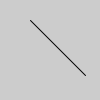line()#
Draws a line (a direct path between two points) to the screen.
Examples#

def setup():
py5.line(30, 20, 85, 75)

def setup():
py5.line(30, 20, 85, 20)
py5.stroke(126)
py5.line(85, 20, 85, 75)
py5.stroke(255)
py5.line(85, 75, 30, 75)

def setup():
py5.size(100, 100, py5.P3D)
# drawing lines in 3D requires P3D
# as a parameter to size()
py5.line(30, 20, 0, 85, 20, 15)
py5.stroke(126)
py5.line(85, 20, 15, 85, 75, 0)
py5.stroke(255)
py5.line(85, 75, 0, 30, 75, -50)
Description#
Draws a line (a direct path between two points) to the screen. The version of line() with four parameters draws the line in 2D. To color a line, use the stroke() function. A line cannot be filled, therefore the fill() function will not affect the color of a line. 2D lines are drawn with a width of one pixel by default, but this can be changed with the stroke_weight() function. The version with six parameters allows the line to be placed anywhere within XYZ space. Drawing this shape in 3D with the z parameter requires the P3D parameter in combination with size() as shown in the third example.
Underlying Processing method: line
Signatures#
line(
x1: float, # x-coordinate of the first point
y1: float, # y-coordinate of the first point
x2: float, # x-coordinate of the second point
y2: float, # y-coordinate of the second point
/,
) -> None
line(
x1: float, # x-coordinate of the first point
y1: float, # y-coordinate of the first point
z1: float, # z-coordinate of the first point
x2: float, # x-coordinate of the second point
y2: float, # y-coordinate of the second point
z2: float, # z-coordinate of the second point
/,
) -> None
Updated on March 06, 2023 02:49:26am UTC
